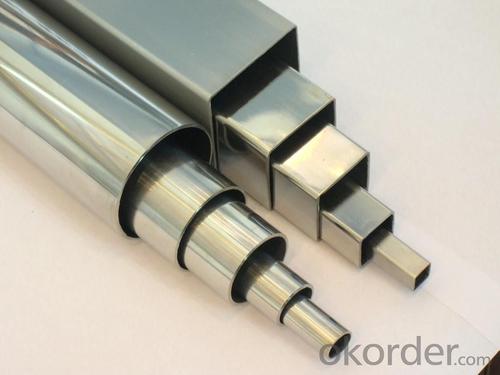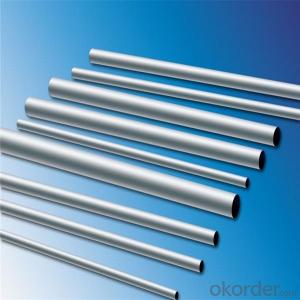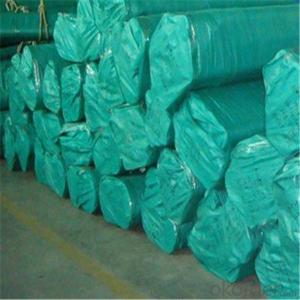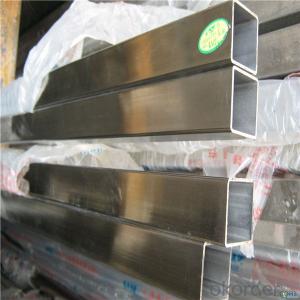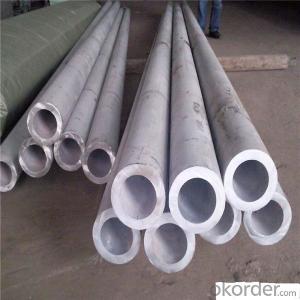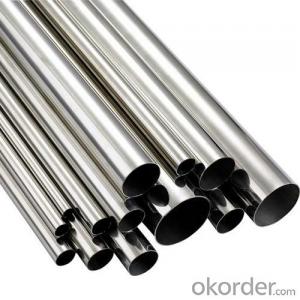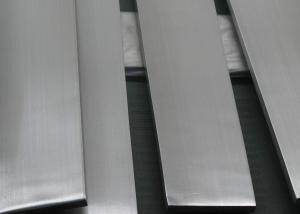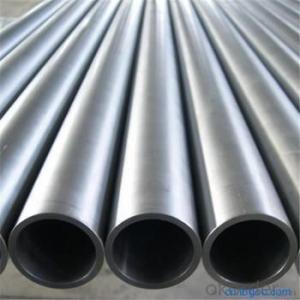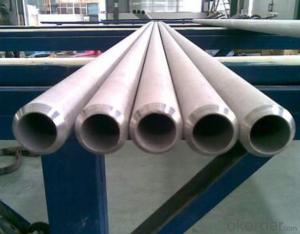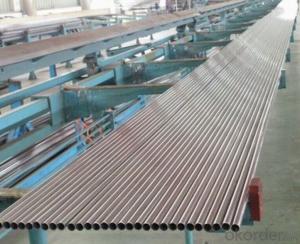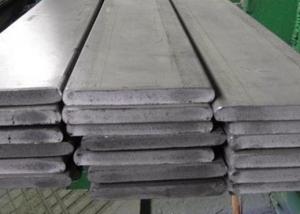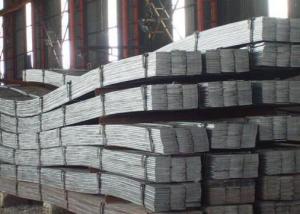Precision finishing 316L Stainless seamless Steel pipes manufacturer Wuxi
- Loading Port:
- Shanghai
- Payment Terms:
- TT OR LC
- Min Order Qty:
- 4 m.t.
- Supply Capability:
- 4000 m.t./month
OKorder Service Pledge
OKorder Financial Service
You Might Also Like
Specification
Precision finishing 316L Stainless seamless Steel pipes Wuxi manufacturer
Product Description
Specifications of Stainless Seamless Steel pipes:
1. Independent warehouse & factory
2. Quick delivery (within 3-7 days)
3. Best service
4.High quality with reasonable price
5.High efficiency
6.Good reputation
7. Samples can be provided as your requirements.
Technical notes:
Introduction
316L( 00Cr17Ni14Mo2 or 022Cr17Ni12Mo2 ) stainless steel is one of Austenitic stainless steel. As a versatile steel,
it has good corrosion resistance, heat resistance, low temperature strength and
mechanical properties. Meanwhile, it is quite good in pressing, bending and other
thermal processing.No heat harding and non magnetic.
| ITEM | cold/hot rolled 316L stainless steel Pipe) | ||||||
| Specification | as your requiremen | ||||||
| Surface | BA/2B/4K/8K/HL/NO.1/NO.2/NO.4/NO.8 | ||||||
| Type | pipe/tube | ||||||
| Thickness | 0.1mm~100mm or as your requirement | ||||||
| Mill | TISCO/ BAOSTEEL/ JISCO/ ZPSS | ||||||
| Usage | Plate heat exchanger, bellows, household goods (1,2 tableware, cabinets, indoor pipes, water heaters, boilers, bath), auto parts (windshield wipers, muffler, moldings), medical equipment, building materials, chemical, food industry , agriculture, ship parts, and so on. 310s stainless steel is a nationally recognized food-grade stainless steel. | ||||||
| Packing | Standard export packing | ||||||
| Payment terms | 1.30%T/T in advance, the balance against the B/L copy | ||||||
| 2.30%T/T in advance, the balance against the L/C at sight | |||||||
| 3.100%L/C at sight | |||||||
| Dilivery time | 1.10days after receving the deposit of T/T | ||||||
| 2.10days after receving the L/C original | |||||||
Packaging & Shipping
| Packaging Detail: | interlayer paper kraft paper wooden packing or as your requirement |
| Delivery Detail: | 3-10 days after received the deposit of T/T or L/C |
Our Services
|
|---|

FAQ
The reason why you Choose us
ISO System
SGS and BV Audited company .
Industry experience over 20 years.
Management Systems-Internal Software
Finished Product Inventory-More Than 500 Tons.
Raw Material inventory -Over 800 Mertic Tons.
Shipment of goods -More than 30 countries worldwide.
We have the most convenient transport and prompt delivery.
We offer competitive price with best service .
We have high technical production line with top quality products.
We have win high reputation based on best quality products.
I am looking forward to building good business relationship with you.
- Q: What are the different types of stainless steel pipe fittings?
- There are several types of stainless steel pipe fittings, including elbow fittings, tee fittings, cross fittings, reducer fittings, and coupling fittings.
- Q: Are stainless steel pipes suitable for high-pressure applications?
- Yes, stainless steel pipes are suitable for high-pressure applications. Stainless steel is known for its excellent strength and corrosion resistance, making it a reliable choice for handling high-pressure fluids or gases. Additionally, stainless steel pipes have the ability to withstand extreme temperatures, making them suitable for a wide range of high-pressure applications in industries such as oil and gas, chemical processing, and aerospace.
- Q: Can stainless steel pipes be used for structural purposes?
- Yes, stainless steel pipes can be used for structural purposes. Stainless steel is known for its strength and durability, making it suitable for various structural applications such as construction, infrastructure, and industrial projects. Its corrosion resistance properties also make it a preferred choice for environments that are exposed to moisture or chemicals.
- Q: Can stainless steel pipes be used in the agriculture industry?
- Indeed, the agriculture industry can employ stainless steel pipes. As a remarkably sturdy and corrosion-resistant material, stainless steel proves ideal for diverse agricultural applications. For instance, stainless steel pipes find frequent use in agricultural fields for irrigation systems, water distribution networks, and drainage systems. Their resistance to rust, corrosion, and chemical harm guarantees a prolonged lifespan despite the harsh agricultural environment. Moreover, stainless steel pipes offer convenience in terms of cleaning and maintenance, rendering them a favored option for transporting an array of liquids and gases within the agriculture industry.
- Q: What is the difference between ferritic and austenitic stainless steel pipes?
- The primary distinction between ferritic and austenitic stainless steel pipes lies in their microstructure and composition, resulting in different properties and applications. Ferritic stainless steel pipes possess a ferrite microstructure, characterized by a body-centered cubic crystal structure. They boast high chromium levels (typically 10-30%) and low carbon content. This low carbon composition grants them excellent resistance against corrosion, though they are susceptible to sensitization and intergranular corrosion at elevated temperatures. Furthermore, they exhibit commendable durability, heat resistance, and magnetism, rendering them suitable for various uses such as automotive exhaust systems, architectural structures, and heat exchangers. In contrast, austenitic stainless steel pipes possess an austenite microstructure, characterized by a face-centered cubic crystal structure. These pipes contain high levels of chromium (usually 16-26%) and nickel (typically 6-22%), alongside low carbon content. Austenitic stainless steel pipes demonstrate superior resistance against corrosion, even in highly aggressive environments. They are non-magnetic, extremely ductile, and possess high toughness, making them ideal for industries such as chemical processing, food and beverage, pharmaceuticals, and medical equipment manufacturing. Additionally, they are less prone to sensitization and intergranular corrosion compared to their ferritic counterparts. To summarize, ferritic stainless steel pipes possess a ferrite microstructure, good corrosion resistance, and magnetism, while austenitic stainless steel pipes possess an austenite microstructure, superior corrosion resistance, non-magnetic properties, and enhanced mechanical properties. The choice between ferritic and austenitic stainless steel pipes hinges on the specific application, desired properties, and environmental conditions.
- Q: What are the different types of fittings used with stainless steel pipes?
- Some of the different types of fittings used with stainless steel pipes include couplings, elbows, tees, reducers, flanges, and valves. These fittings are designed to connect, redirect, or control the flow of fluids or gases in a stainless steel piping system.
- Q: How do you prevent galling in stainless steel pipes?
- One way to prevent galling in stainless steel pipes is by applying an anti-seize compound or lubricant to the threaded connections. This helps to reduce friction and prevents the surfaces from seizing together. Additionally, ensuring proper thread engagement and avoiding excessive tightening can also help prevent galling.
- Q: What is the difference between 321 and 347 stainless steel pipes?
- The composition of their alloys is the main distinction between 321 and 347 stainless steel pipes. Both grades of stainless steel are titanium-stabilized to prevent the formation of harmful chromium carbides when exposed to high temperatures. However, 347 stainless steel contains additional columbium (niobium), which enhances its resistance to intergranular corrosion. This makes 347 stainless steel pipes suitable for applications that involve exposure to high temperatures and corrosive environments, such as in the petrochemical industry or exhaust systems. On the contrary, 321 stainless steel pipes exhibit excellent resistance to oxidation and scaling at elevated temperatures, making them ideal for applications that require continuous exposure to high heat, like in aircraft exhaust systems or furnace parts. Ultimately, the choice between 321 and 347 stainless steel pipes depends on the specific requirements of the application, with 347 offering superior intergranular corrosion resistance and 321 providing better oxidation resistance.
- Q: Are stainless steel pipes suitable for hydraulic applications?
- Yes, stainless steel pipes are suitable for hydraulic applications. They offer excellent corrosion resistance and durability, making them ideal for use in hydraulic systems where fluid flow and pressure are involved. Additionally, stainless steel pipes can handle high temperatures and are resistant to cracking, making them a reliable choice for hydraulic applications.
- Q: Are stainless steel pipes suitable for power plants?
- Yes, stainless steel pipes are highly suitable for power plants. They offer exceptional resistance to corrosion, high temperatures, and pressure, making them ideal for transporting various fluids and gases within power plants. Additionally, stainless steel pipes have excellent strength and durability, ensuring long-term reliability in the demanding operating conditions of power plants.
Send your message to us
Precision finishing 316L Stainless seamless Steel pipes manufacturer Wuxi
- Loading Port:
- Shanghai
- Payment Terms:
- TT OR LC
- Min Order Qty:
- 4 m.t.
- Supply Capability:
- 4000 m.t./month
OKorder Service Pledge
OKorder Financial Service
Similar products
Hot products
Hot Searches
Related keywords


